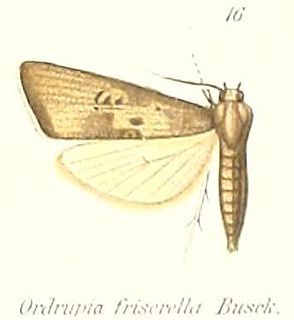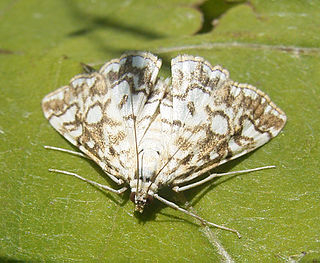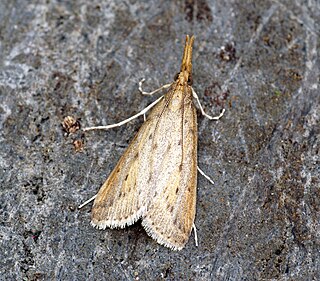
Copromorphidae, the "tropical fruitworm moths" is a family of insects in the lepidopteran order. These moths have broad, rounded forewings, and well-camouflaged scale patterns. Unlike Carposinidae the mouthparts include "labial palps" with the second rather than third segment the longest. With other unusual structural characteristics of the caterpillar and adult, it could represent the sister lineage of all other extant members of this superfamily. The genus Sisyroxena from Madagascar is also notable for its unusual venation and wing scale sockets.

Spilomelinae is a very species-rich subfamily of the lepidopteran family Crambidae, the crambid snout moths. With 4,132 described species in 340 genera worldwide, it is the most speciose group among pyraloids.

The Lecithoceridae, or long-horned moths, are a family of small moths described by Simon Le Marchand in 1947. Although lecithocerids are found throughout the world, the great majority are found in the Indomalayan realm and the southern part of the Palaearctic realm.

Amata is a genus of tiger moths in the family Erebidae. The genus was erected by Johan Christian Fabricius in 1807.

Kiwaia is a genus of moths in the family Gelechiidae. Two subgenera are currently recognised, (i) the nominotypical subgenus with 25 species from New Zealand, and (ii) subgenus Empista with 4 species from the Palaearctic Region.

Eressa is a genus of moths in the family Erebidae. The genus was erected by Francis Walker in 1854.

Scoliacma is a genus of tiger moths in the family Erebidae. The genus was erected by Edward Meyrick in 1886.
Piletocera is a genus of moths of the family Crambidae. The genus was first described by Julius Lederer in 1863.
Timyra is a genus of moths in the family Lecithoceridae.

Macrobathra is a genus of moths in the family Cosmopterigidae. Most species are endemic to Australia.

Autosticha is a genus of gelechioid moths. It belongs to the subfamily Autostichinae, which is either placed in the concealer moth family (Oecophoridae), or in an expanded Autostichidae. It is the type genus of its subfamily. Originally, this genus was named Automola, but this name properly refers to a fly genus in family Richardiidae.

Acentropinae is a fairly small subfamily of the lepidopteran family Crambidae, the crambid snout moths. Species of this subfamily are exclusively found in wetlands and aquatic habitats.
Eressa aperiens is a moth of the family Erebidae. It was described by Francis Walker in 1865. It is found in India.

Eressa confinis is a moth of the family Erebidae. It was described by Francis Walker in 1854. It is found in India, Bhutan, Sri Lanka, Myanmar, Taiwan and China.
Eressa geographica is a moth of the family Erebidae. It was described by Edward Meyrick in 1886. It is found in Australia.
Copromorpha is a genus of moths in the family Copromorphidae.

Schoenobiinae is a subfamily of the lepidopteran family Crambidae. The subfamily was described by Philogène Auguste Joseph Duponchel in 1846.
Thiotrichinae is a subfamily of moths in the family Gelechiidae.
Apatetrinae is a subfamily of moths in the family Gelechiidae. The subfamily was described by Edward Meyrick in 1947.










